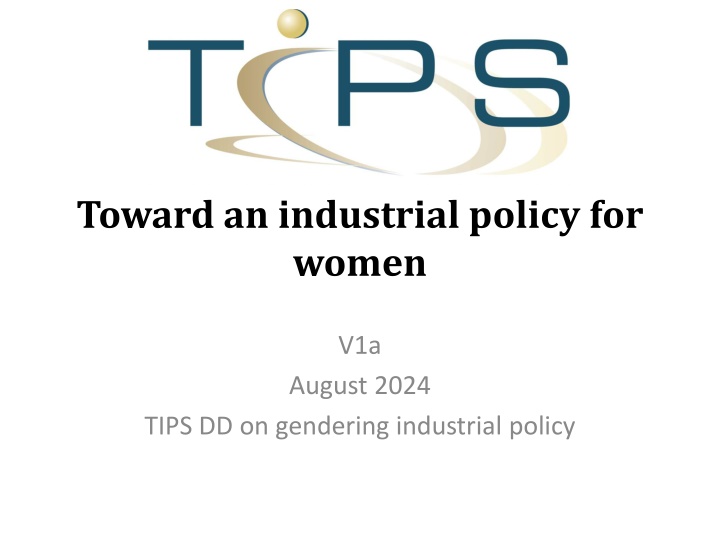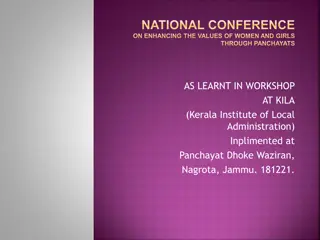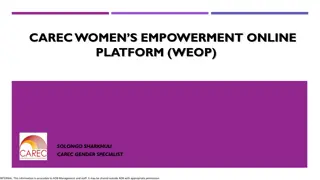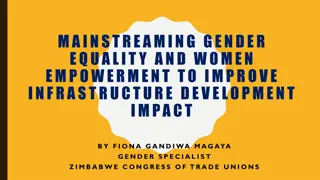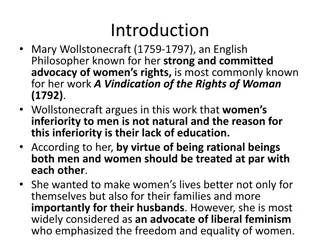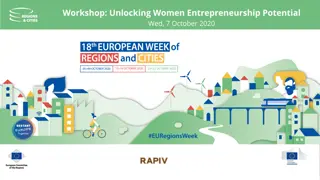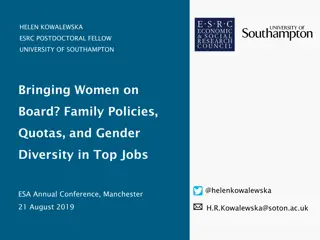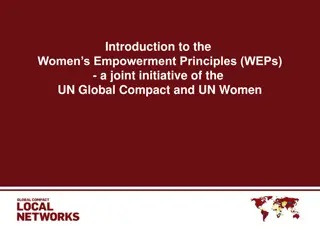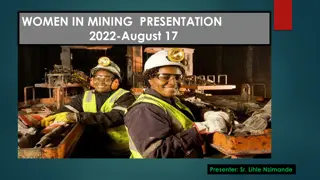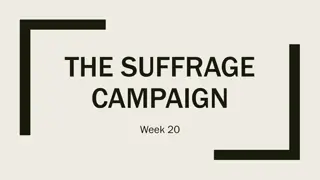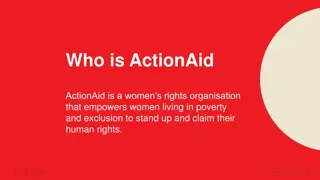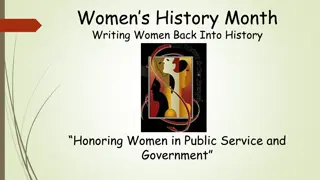women
South Africa faces unique deficits in employment and inequality, with challenges in industries like mining and manufacturing. Despite high exports, there are limited opportunities for women in capital-intensive sectors. Addressing these issues requires new support systems, infrastructure development, and overcoming barriers related to family roles. The focus on exporting manufactures is not straightforward due to competition with Asian workers and limited market access. Empowering historically excluded groups necessitates restructuring the economy to create more inclusive opportunities.
Download Presentation

Please find below an Image/Link to download the presentation.
The content on the website is provided AS IS for your information and personal use only. It may not be sold, licensed, or shared on other websites without obtaining consent from the author.If you encounter any issues during the download, it is possible that the publisher has removed the file from their server.
You are allowed to download the files provided on this website for personal or commercial use, subject to the condition that they are used lawfully. All files are the property of their respective owners.
The content on the website is provided AS IS for your information and personal use only. It may not be sold, licensed, or shared on other websites without obtaining consent from the author.
E N D
Presentation Transcript
Toward an industrial policy for women V1a August 2024 TIPS DD on gendering industrial policy
SAs unique deficits Employment Extraordinarily low employment ratio around 40%, compared to global norm of 60% Women at 35% (up from 25% in mid-1990s) Men at 45%, and stable Black women have much the lowest paid employment levels Biggest deficit is self- employment 4% of South African adults are self- employed, compared to 15% in upper middle income countries ex China (24% in China) Need new support systems and infrastructure to rebuild, not just providing finance and ending apartheid laws Women face additional barriers around family roles and household infrastructure Inequality Big businesses capture bulk of incomes and market in 2021, 432 companies paid two thirds of company income tax Amongst the most unequal household incomes in the world Reproduces in part due huge differences in inherited assets, access to quality education and infrastructure Class inequalities still align largely with race and gender, despite great progress from 1994 Mining dependency Minerals, metals and coal 55% of SA goods exports, compared to 35% (mostly petrol) for other upper middle income countries ex China 10% of SA GDP and 5% of jobs almost none for women Clothing and electronics assembly under 5% of SA exports, compared to almost 15% for other upper middle income countries Slow growth GDP growth equal to peers from 1994 to 2011, recovering from much slower growth in 1980s Since then, lagging increasingly behind, especially due to end of mining boom, state capture and infrastructure deterioration Virtually no growth in GDP from 2019, compared to 1% a year in Latin America and 2% in other upper middle income countries excluding China Means harder to restructure economy to empower historically excluded
Why not just export manufactures? Asia industrialised by exporting consumer manufactures especially to global North Benefited majority due to initial focus on labour- intensive industries clothing and plastic products, then electronic assembly, only more recently auto and capital goods Able to compete based on Cheap labour compared to global North Regional development expanded demand and investment sources, plus synergies on infrastructure South Africa Competing with Asian workers, not US or Europe pay in SA is around the same as in China Competing with established Asian producers to supply retailers and brand names Incomparably smaller domestic and regional markets Only auto assembly and some niche products, mostly linked to mining, have broken into international manufacturing trade All capital intensive, with few women workers Result: even high exports have not led to substantial new opportunities (auto value chain employs 125 000 max) Successes in labour-intensive export activities since 1994: Horticulture Cultural services (entertainment, design) Health and education (mostly provided in SA for foreigners) Tourism Digital and professional services (software, website design, engineering, legal, high-end security, finance) Trade data systematically undercount services exports, which include (a) services to foreigners provided in SA and (b) services provided in foreign countries from SA
Inclusion and industrialisation Internationally, services have generated virtually all net new employment since 1995 In China: Agricultural employment down from 60% in 1991 to 25% in 2019 Manufacturing up from 21% to 27% Services from 19% to 47% In SA and globally, services Provide pay and conditions on par with manufacturing Are knowledge intensive Are critical for building human and social capital and national competitiveness Are especially important for women s careers (except for some professional business services) ILOStat and WDI
An industrial policy for inclusive industrialisation in SA Prioritise long-term aims of employment, equality, diversification and growth technological upgrades and exports as means, not ends in themselves Prioritise innovation where it can generate new opportunities on a mass scale Replace risk aversion with risk management When is job creation more important than higher productivity? For established business: Focus on improving government services and holding down input costs
Overcoming the employment deficit Requires significant changes in Sectors and industries supported by government departments Scale of support for intermediaries able to reach small businesses in poor communities Government systems and rules for risk management and payments Systems to ensure support from other agencies structured engagement and unambiguous prioritisation Industries: Services of all kinds Forestry and agriculture, especially contract schemes for smallholders Construction including public works schemes, solar installation in townships and home building/upgrading Light manufacturing, especially local food systems, clothing (not textiles) and other labour- intensive consumer goods Innovative clusters and production systems: End result: more small producers meeting local needs or feeding into formal VC Critical = public, private and social intermediaries that can create ecosystems for small producers e.g. contracting out in agriculture and forestry, franchising in services such as fast food, tutoring, gardening and cleaning Township enterprises that serve the community or work from new commercial, retail and where desirable light industrial sites Increase labour intensity in the public services on the model of community health workers and teaching assistants
Support for established industries Prioritise competitiveness and growth prospects, not rescue operations Protect against competition (import tariffs, guaranteed offtake/ localisation agreements) only if it supports competitiveness strategies, rather than replacing them More re-active and responsive stance: More reliable and affordable electricity, freight transport, water and broadband including metros and secondary cities More efficient licencing, without sacrificing standards Focus on cost cutting, not protection Consistent, large-scale measures to ensure rents from commodities go to downstream manufacturers (e.g. soya for poultry; iron ore, coal and scrap for steel; textiles for clothing) Incentivise upgrades in work organisation, technologies and product lines
Takeaways Changes in the way the state functions: Unambiguous prioritisation as basis for alignment across the state Reallocation of capacity within the dtic Management of risks resulting from structural change, rather than just avoiding them Address the specific obstacles facing historically excluded, including from gender roles To address the continued economic subordination of women, industrial policy has to prioritise SA s unique socioeconomic needs Walking on two legs: Massively scale up programmes to create opportunities and empower our people through innovative programmes Help established producers become more competitive, rather than just protecting them from competition
